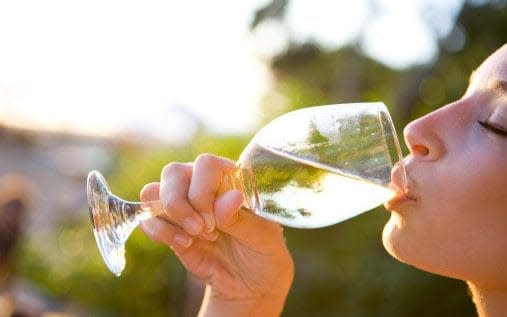Why white wine could be doing you more harm than you think

Finally summer is here - otherwise known as the perfect excuse for a cool glass of chablis. As a nation, we drink more white wine than any other colour. Last year, 47 per cent of UK wine sales were white bottles, 42 per cent were red and 11 per cent were rose, according to The Statistics Portal. But as with all other guilty pleasures (salt, fat, watching Gogglebox) too much can be a bad thing.
Despite its clear, refreshing palate, white wine contains more sugar and sulphites than red, rose, beer and many spirits.
Another issue is just how effortlessly it slips down, despite being 13 per cent ABV (alcohol by volume), meaning we drink far more of it than we realise. Andrew Misell a director at charity Alcohol Research UK, says: “White wine doesn’t have as strong flavours, so for many it’s an easy way to unintentionally drink too much. That's what makes it problematic.”
According to official guidelines, we shouldn't be downing more than 14 units a week - yet more than 9 million people in England regularly exceed this. In the UK, alcohol accounts for 10 per cent of all death and disease, making it one of the three biggest lifestyle risk factors after smoking and obesity.

But there are hints that the tide is turning against white wine. Anecdotally, increasing numbers of people are complaining that it is too sweet, too acidic or that it brings out their inner ‘white wine witch’ - seemingly getting them far more drunk than other beverages and leading to worse hangovers.
So, with the help of some experts, here’s want to watch out for and why a glass of white wine might not be as restorative as you think.
CANDIDA
Chef Gizzi Erskine recently admitted that she has stopped drinking white wine. Why? It triggers her candida, she told Telegraph columnist Bryony Gordon in her Mad World podcast. The yeast infection, found in the gastrointestinal tract, causes chronic fatigue, depression, joint pain and impairs basic gut function.
Nutritional therapist Emma Cockrell agrees that white wine’s high sugar content could cause, or at the very least exacerbate, the condition.
“If you drink white wine on a regular basis - combined with other factors such as having taken antibiotics, having been pregnant when hormone fluctuations upset the balance of microbes in the gut, or experiencing stress - a glass of wine a night can very easily tip the balance. Candida is fed by sugars, and wine is a great source of that.”
According to the Food Standards Agency, a medium glass of white wine can contain up to 10 times as much sugar as one of red; 3g per 100ml, compared to 0.2g in red and 2.5g in rose.
Comparatively, there is pretty much zero sugar in highly-distilled spirits such as gin, vodka, rum and whiskey, as well as beer.

ROSECEA
Research published last month by Brown University in America found that even small amounts of white wine can increase your chances of developing rosacea. A study of 83,000 women showed that just one to three glasses a month raises the risk of the inflammatory skin condition by 14 per cent. Five or more white wines a week upped that to 49 per cent.
Dr Nick Lowe, consultant dermatologist at The Cranley Clinic in London, believes this is down to the alcohol content of white wine acting as a “vasodilator” - something that widens the blood vessels in the skin.
“When you enlarge the blood vessels, your facial redness increases,” he says. “All people will get it from alcohol to a degree but some are genetically predisposed to be blushers or flushers. There is also a group of people whose skin reacts very vigorously to higher levels of sulphites in the white wine.”
To combat redness he suggests using topical creams such as Acclenz blemish serum (£49, drnicklowe.com) or the antibiotic Metronidazole (also known as Rozex gel), combined with targeted laser treatments to reduce blood flow to skin. There is also a chance, he says, that consuming too much white wine - a high-glycaemic carbohydrate - encourages the growth of a tiny skin mite called Dermodex Follicularum, known to exacerbate rosacea.
WEIGHT GAIN
The charity Drink Aware likens wine to our favourite junk food treats in an attempt to show how calorific it is. One small 175ml glass contains 160 calories, similar to a slice of Madeira cake. A large glass (250ml) with 228 calories is the equivalent of an ice cream cone.
While a bottle equals two chocolate croissants, or 680 calories. Light, sweeter whites such as pinot grigio and riesling have fewer calories than drier whites, with higher ABVs, such as sauvignon blanc and chardonnay.
One study in 2014 showed that regular wine drinkers consume an excess of 2,000 liquid calories a month, with alcohol contributing to around 10 per cent of their total calorie count. Drink Aware says "alcohol reduces the amount of fat your body burns for energy.
While we can store nutrients, protein, carbohydrates, and fat in our bodies, we can't store alcohol. So our systems want to get rid of it, and doing so takes priority. All the other processes that should be taking place (including absorbing nutrients and burning fat) are interrupted."

LIVER DISEASE
Andrew Langford, chief executive of the British Liver Trust, says there has been a 400 per cent increase in liver disease over the last 30 years, and places some blame on the calorific quality of white wine. “Consuming too many calories has an unhealthy effect on the liver, causing fatty deposits and liver disease.
“Working women who go out for a couple of drinks with colleagues and then have a couple more because they believe it helps them sleep - a complete fallacy - are particularly at risk.
“We campaign for clearer labelling on alcohol products. Bottles of white wine should say not only how many alcohol units, but also how many calories are in there.”
The British Liver Trust has a ‘Love Your Liver’ online health scanner, where users can answer questions to see how at-risk they are of developing liver disease.

SKIN CANCER
A study by Brown University, published in 2016, found that white wine lovers have a 13 per cent higher risk of developing the skin cancer melanoma, compared to drinkers of other types of alcohol. While little research has been done to explain these findings, one theory puts the discrepancy down to a compound in alcohol called acetaldehyde.
This can damage our DNA and prevent its repair, and research has shown higher levels of it in wine. And while red varieties contain antioxidants, which are thought to mitigate the effects, white does not have the same qualities.
Dr Lowe says, “It is possible there is a link but it is much more complicated than we think.” He believes other lifestyle factors typically associated with drinking - increased time spent outdoors, a suppressed immune system, poor diet and smoking - may notch up the risk.
DEPRESSION
Sulphites is a buzzword when it comes to wine. These are naturally-present compounds on grapes but have also been added to wine for hundreds of years as a preservative, thanks to their antioxidant and antibacterial properties.
Most modern wines typically have 20 to 200 parts per million (PPM) and anything containing more than 10 PPM must say so on the label. Anecdotally, sulphites have been linked to ‘drinking blues’ and depression, as well as allergies, asthma, bad dreams and headaches.
Sweet white wines typically contain the most sulphites, as more are added to halt the fermentation process. Another reason why a night on the white might make that hangover worse than usual.

 Yahoo News
Yahoo News 